Last updated: October 19, 2023
Article
Challenging The Ranger Image
In spite of programs to encourage hiring of individuals with disabilities, it was often others’ misconceptions or discomfort that prevented women with disabilities from getting National Park Service (NPS) jobs. Those hired in the 1970s and early 1980s brought diverse skillsets and new perspectives to the workforce. Like the earliest women rangers in the 1910s and 1920s, they often only had short-term positions. They all challenged ideas of what it takes to be a park ranger.
Words Matter
The language used to describe people with disabilities and their specific disabilities has changed over time. Some words commonly used in the past are now broadly recognized as offensive or belittling toward persons with disabilities. In this article archaic terms that are part of titles, direct quotes, or integral to the point being made have been retained for historical accuracy. In all other instances, however, the terminology has been updated to reflect current standards of respect and inclusivity.
A Legal Framework
A handful of laws designed to support federal employment of persons with disabilities were passed in the early to mid-1900s, but unearthing stories of NPS employees with disabilities before the 1970s has been a challenge. It’s reasonable to assume that some veterans with disabilities worked for the NPS following World Wars I and II and that they likely would have been exclusively men.
US affirmative action policies began through executive order in 1961. The Civil Rights Act was passed in 1964. Neither, however, addressed discrimination against persons with disabilities. It was the Architectural Barriers Act of 1968 that led the NPS to begin focusing on accessibility issues because the law required that buildings or facilities designed, built, or altered with federal dollars or leased by federal agencies be accessible.
It wasn’t until the Rehabilitation Act of 1973 that the exclusion of individuals with disabilities was defined as a form of discrimination, and discrimination against them in employment, programs, and activities was banned. The Civil Service Reform Act of 1978 offered further support for employees with disabilities, including hiring preferences for veterans with disabilities and paying for services such as sign language interpreters and readers for employees who are deaf or blind to enable them to complete their work.
Together these laws established a strong foundation for hiring more employees with disabilities. In practice, however, there were still many obstacles for getting jobs in the NPS.
“The Filing Cabinets Are Too High” and Other Obstacles
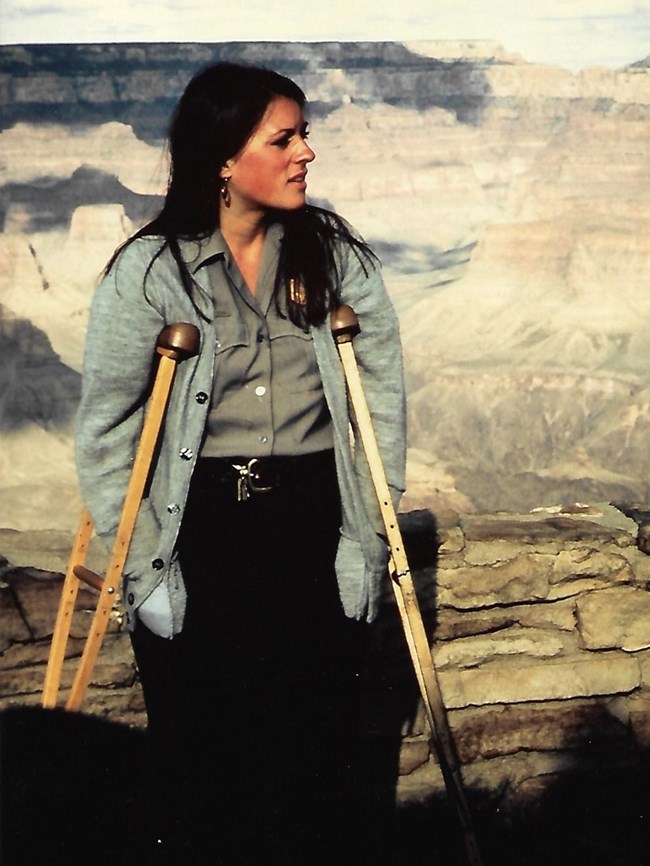
Following passage of laws in the late 1960s and early 1970s, NPS efforts focused primarily on making its facilities, programs, and services accessible for visitors. In 1977 NPS Director William Whalen created an affirmative action task force to “determine methods and means” for successful implementation of the NPS affirmative action program. The task force was comprised of 12 employees, one of whom—Esther O. Hays—had a disability. The task force observed that there “appears to be a reluctance on the part of many employees to hire or work with handicapped persons. Consequently, the Service is missing out on an opportunity to provide meaningful employment to some very skilled persons.” About this time, the NPS began to assess its administrative and training facilities for accessibility for employees with disabilities.
In October 1979, the NPS Western Region was still reporting that “Supervisors are often under the misconception that a handicapped person cannot perform in the job because ‘the filing cabinets are too high’ or ‘the telephone can’t be answered by a deaf person.’” The report goes on to note that “job modifications can easily be accomplished to accommodate these people.”
Arguably another significant obstacle to getting NPS jobs was a bias, perhaps unconscious, towards the image of a park ranger as an able-bodied, outdoorsy person. The NPS has a long history of Protecting the Ranger Image. In some instances the NPS uniform itself presented hidden obstacles for employees with some types of disabilities.
Building Momentum
In spite of these barriers, some women with disabilities were hired in the 1970s. One of the earliest was Marilyn Strack who began working at Muir Woods National Monument in October 1973. Strack, born with a limb difference on her left arm, earned a BA in psychology from the University of California at Berkeley but struggled to find an employer willing to hire her. In a 1974 newspaper article she stated, "Last summer after several exhustive, futile months of job hunting, I was so depressed I just felt that I could die on the street--that there was nothing for me anywhere." She worked in the entance station and information office at the park. Although she expressed an interest in remaining with the NPS, it's not clear how long she did so.
Esther O. Hays was working at George Washington Memorial Parkway by November 1977. However, she probably worked for the NPS for some time before that, as all employees selected for the 1977 affirmative action task force were “familiar with the operation of the National Park Service” and had “in the past indicated deep interest” in the Equal Employment Opportunity (EEO) Program.
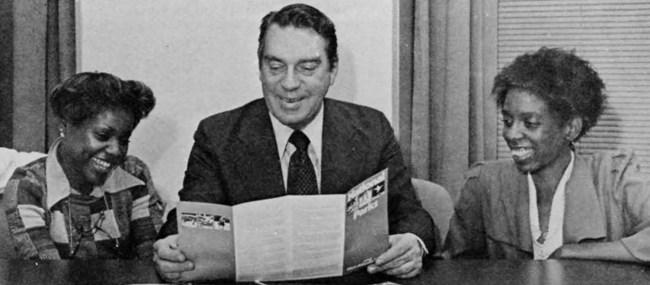
In 1975 students from Gallaudet College, a school for the deaf in Washington, DC, volunteered to work as guides for visitors who were deaf or hard of hearing. At least some of them were probably women. Unfortunately, no additional information about these women has been found.
Darlene Les’Pere and Sheree Moses were hired in early 1978, joining the NPS Mid-Atlantic Region through a new selective placement program designed to place personnel with physical disabilities throughout federal agencies. Both women were hired as clerk-typists. Les’Pere at least may have had a longer career with the NPS, but more research is needed.
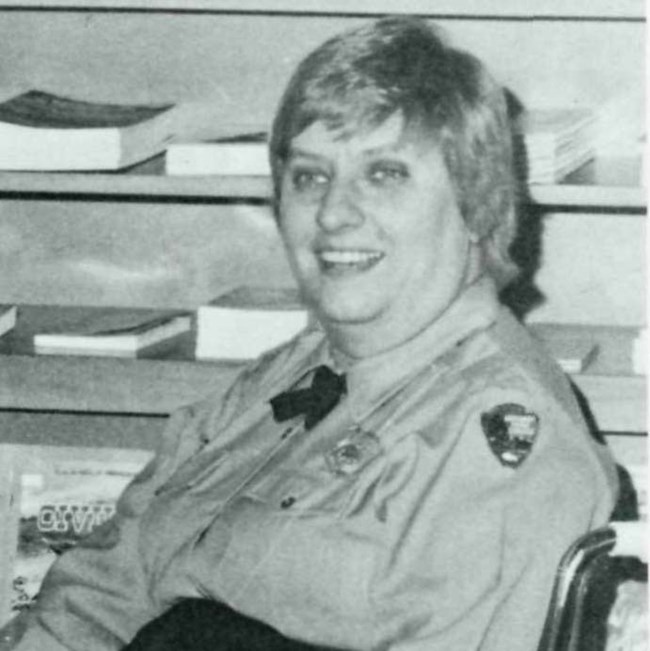
As of December 31, 1979, the NPS reported that 760 employees had disabilities, although only 139 had targeted disabilities such as deafness, blindness, paralysis, convulsion disorders, intellectual disabilities, or mental illness.
One of those employees was Joanne Hodges, who used a wheelchair. She worked as a park aide at the information desk for Chickamauga & Chattanooga National Military Park. In November 1979 she attended the first NPS Women’s Conference in Reston, Virginia.
In reflecting on women’s roles after the conference, Hodges noted that barriers were greater for employees with disabilities stating, “This is the first job I’ve ever had. It’s not as easy for handicapped people.”
Champion Ranger
Coloradan Sydney Jacobs grew up camping and visiting national parks with her family. She recalls that she "always wanted to be a park ranger." As a young adult, she "realized how hard it is to get into the NPS" with veterans from the Vietnam War receiving hiring preference and thought "it wasn't going to happen." Any hope she had of a career as a ranger seemed to end after she was paralyzed from the waist down in a mountaineering accident in the North Cascades in 1974.
Jacobs graduated with a degree in journalism from the University of Washington in 1977. She also swam competitively on the international level, winning medals at the Pan American Games in Mexico City in 1975, the Stoke Mandeville Paraplegic Games in England in 1977, and the 1978 Pan-American Wheelchair Games in Brazil. She competed in the 1976 Paralympics in Toronto and in 1977 set an official national record in the butterfly stroke at the National Wheelchair Games. She was a member of the US Wheelchair Team, winning silver and bronze swimming medals at the 1980 Paralympics in the Netherlands. In 1981 she held three national records for swimming.
She credits her vocational rehabilitation counselor with getting her an interview at the Pacific Northwest Regional Office, a shared NPS and US Forest Service facility, where they wanted to hire someone who used a wheelchair. In 1978 she started with the Forest Service. She transferred to the NPS the next year as an information specialist in the public affairs office.
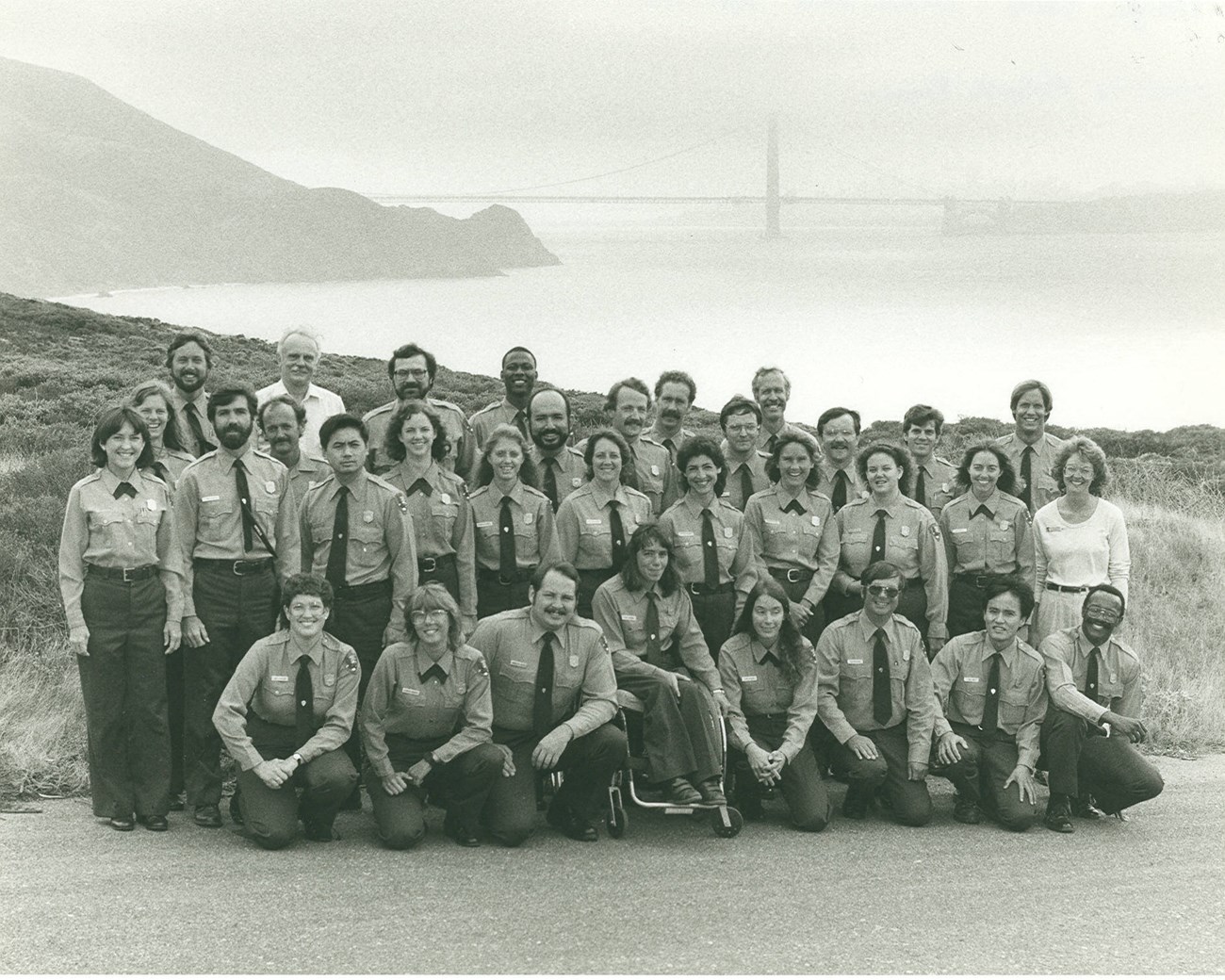
Jacobs' supervisor was "an amazing mentor" and arranged for her to work as a naturalist on Hurricane Ridge in Olympic National Park in summer 1980. The headquarters building wasn't accessible and she recalls that the park superintendent "wasn't happy" that she was working at the park. She lived in park housing for the summer and led three meadow walks and gave two interpretive talks each day. She recalls that she "loved being a naturalist, teaching, and environmental education."
Jacobs prepared a report on the park’s accessibility to persons in wheelchairs but doesn't describe herself as an accessibility activitist. She stated matter of factly that she could "muscle her way around the trails" on Hurricane Ridge which were not easily maneuvered in a wheelchair, noting, "I managed to do my job and didn't make a fuss." She remembers being part of a small group of employees with disabilities, including Shirley Beccue and Ray Bloomer, who would informally share their experiences and support each other.
In 1981 Olympic hired her as a park technician. She supervised the daily operations of the visitor center in Port Angeles, gave fireside programs, and led trail walks. She also managed the park museum collection and interpretive slide file. Jacobs wrote the nomination to list the park as a World Heritage Site and she was named one of 10 Department of the Interior “Handicapped Employees of the Year" in 1982.
Jacobs attended the NPS ranger skills training course at Golden Gate National Recreation Area in 1984. The class photo documents that she wore the standard NPS uniform but shoes with hook and loop straps rather than the standard uniform lace-up shoes. She also attended training at Grand Canyon National Park and the NPS Mather Training Center in Harpers Ferry, West Virginia.
Following her accident, Jacobs took up kayaking. She became a passionate advocate for wilderness use by people with disabilities. In 1984, she and two men with disabilities completed a 200-mile sea kayaking trip around Prince William Sound.
Jacobs left the NPS around June 1985 to attend graduate school in Washington, DC. She recalls that she was "terrified" to move east and planned to return to the West as quickly as possible. She earned her MA in museum education at George Washington University. She remembers telling a friend that she would only stay in the East "for a dream job or the right man." She quickly found both and it would be more than 30 years before she lived in the West again.
She and her husband took an "epic trip" through South America before raising their two children. Jacobs continued to share her passion for nature and environmental education at a county park in Maryland and in other positions throughout her career.
An International Spotlight
More women employees with disabilities have been identified from 1980 and throughout 1981, which the United Nations declared the International Year of the Handicapped. The designation led to a general increase in recognition for persons with disabilities. Although the NPS had worked for several years to increase the number of staff with disabilities, the fact that these women become easier to find in newspaper accounts around 1981 hardly seems coincidental.
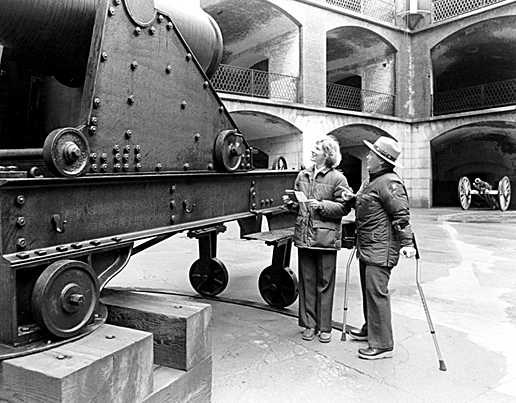
Vicki White was a full-time park technician at Golden Gate National Recreation Area in 1980. As someone who used both crutches and a wheelchair, she worked closely with the park to help modify walkways, restrooms, and other access points to make the park more accessible for visitors with disabilities. White wore the NPS uniform including the hip-length parka. Her shoes have been identified as Famolaris. While not an official part of the uniform, they were designed for comfort, transferring the body’s weight from heel to arch and from ball to toes, absorbing the shock to the foot and rolling wearers forward with each step. White certainly wouldn’t have been the only woman to wear non-regulation shoes. While it’s unclear if her choice of footwear was related to her disability, they would have offered increased comfort to anyone standing on their feet for long periods of time.
At Lassen Volcanic National Park Rosey Ryan, an employee with disabilities, worked as a clerk in the administrative office during the summer of 1980. No additional information about her is available. A photo of her published in the February 1981 NPS newsletter Courier shows that she wore the NPS uniform, which was unusual for a clerk.
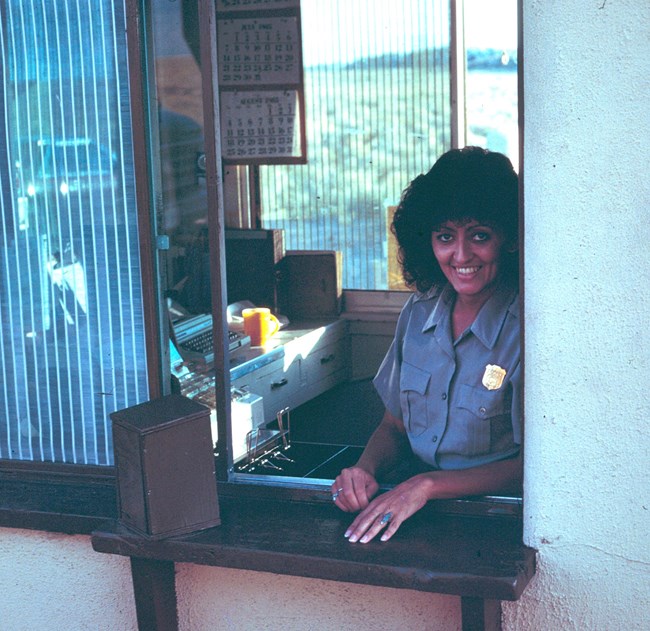
At least two women who were deaf or hard of hearing found short-term work with the NPS in 1980 and 1981. Patricia Ann “Patsy” Otero was hired at White Sands National Monument (now a national park) in 1980. A native of Almagordo, New Mexico, she worked as a park aide at the entrance station and assisted with interpretive programs. Her father, Manuel J. Gamboa, was also a ranger at the park.
Michigan-born Maril Hanby Elliot, who is severely hard of hearing, earned a BS degree from the Oregon State University. Elliot recalled in a June 16, 1983, Monrovia News-Post article that she decided upon a career with the NPS because she “attended a campfire program at Mount Rainier National Park [where] she didn’t understand what was happening and thinking it unfair, decided to do something about it.” She got a job as a park technician at Santa Monica Mountains National Recreation Area in 1980.
Elliot lip-read and signed with visitors who were deaf and the general public. She attended the NPS ranger skills course in spring 1981 at Albright Training Center, an NPS-employee training facility at Grand Canyon National Park.
At Santa Monica Mountains, Elliot created several environmental educational programs, including providing overnight experiences for students from schools for the deaf. In 1982 she was nominated outstanding handicapped federal employee for the Department of the Interior for providing programs to nearly 8,000 visitors with disabilities the previous year. That same year, at age 26, she was selected as one of the Outstanding Young Women of America.
Elliott also led efforts to install telephones for people who were hearing-impaired at park headquarters and encouraged nine other park employees to take sign-language classes. She worked for the NPS there until at least 1983. After leaving the NPS she went on to teach American Sign Language at Olympic College in Washington.
Turning Discrimination into Opportunity
Eileen Szychowski planned her trip to Grand Canyon National Park a year in advance. She recalls, “In 1981 I traveled with some friends to Grand Canyon for what I believed would be the adventure of a lifetime: a mule ride down to the bottom of the canyon. I was, after all, a very experienced horsewoman and never figured that having a disability would have any bearing on my being permitted to ride the mules. Imagine my horror when I showed up in person and was told I would not be permitted.” Szychowski has both arm and leg disabilities and walks with wooden crutches.
Although Szychowski’s friends were willing to cancel their plans to hike into the canyon, she wouldn’t hear of it after their 1,000-mile journey to get there. Confident that she would be able to find plenty to occupy herself in a spectacular national park, “additional horror ensued as [she] became aware that none of the restaurants or tour buses were accessible.” In a newspaper article published in 1982, she noted, “The trails, the exhibits—they are all designed on the assumption that everybody sees, hears, feels, and walks."
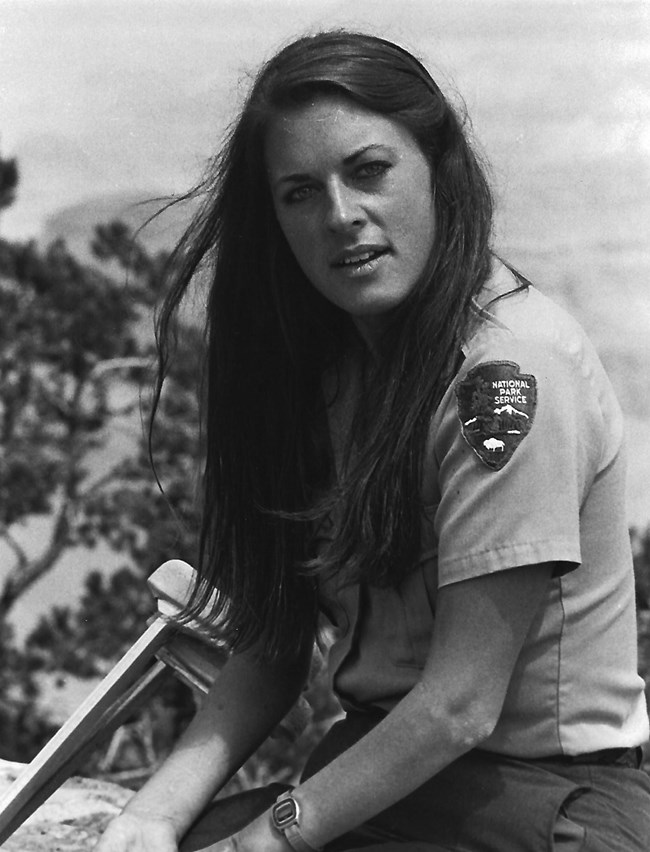
The next day Szychowski returned to Bright Angel Lodge and asked to speak with a manager at the Fred Harvey Company, the concessioner running the mule tours. She met Jan Cutler, director of transportation, who suggested that they have breakfast to discuss her concerns. The next morning Szychowski struggled up the steps into the restaurant for the meeting, knowing it was too important to miss in spite of the obstacles. She began educating Cutler about disability rights. Although the Americans with Disabilities Act (ADA) didn’t yet exist, the Rehabilitation Act of 1973 did. Szychowski knew that they could ask her to demonstrate her ability but couldn’t simply refuse her as they had done. She let Cutler know that although she wasn’t intent on suing, others surely would if their practices didn’t change.
Cutler, whom Szychowski describes as “an enlightened person,” took their conversation to heart and spent the rest of the day taking her on a behind-the-scenes tour and introducing her to various NPS officials. One was Karen Berggren, the special populations coordinator for the park. Szychowski recalls that Berggren remarked, “We’ve been looking for someone like you for a long time.” Berggren introduced her to J.T. Reynolds at Albright Training Center. Reynolds asked Szychowski to put together a four-hour session for an upcoming NPS ranger skills course that fall. As a paid consultant, she returned and presented a class that required rangers to experience the Grand Canyon in wheelchairs and blindfolds.
Those simulated disabilities experiences caught the attention of the park’s superintendent Richard Marks, whom Szychowski describes as “very forward thinking.” He offered her a temporary nine-month position for the next season. After the course Szychowski finally got onto one of the mules but only rode into the canyon far enough to demonstrate her riding ability.
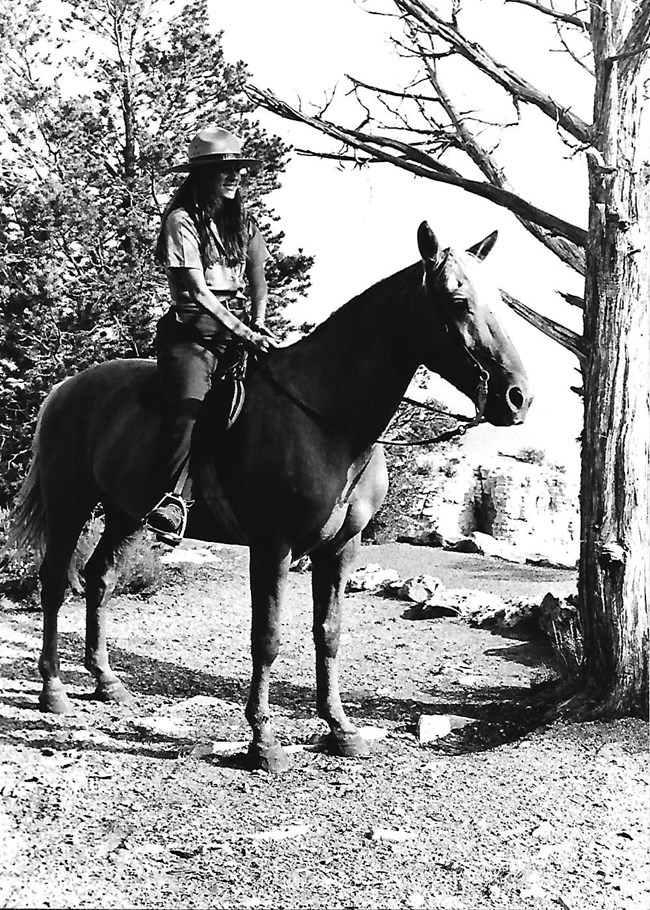
Returning in 1982 as an NPS ranger, she advised on accessibility issues in addition to her work as an interpreter. She found, however, that she had a very different experience as a ranger than a visitor. As an employee, she was at the bottom of the chain of command and although she met many who were advocates and allies, she experienced more resistance working within the system. Some were aghast that she was allowed to use her personal horse, Guenivere, on the job. Trained as a therapy horse, Guenivere worked in partnership with Szychowski in ways that a government horse could not.
She recalls, “I was permitted to use my personal horse to ride into the canyon to gain the first-hand knowledge I would need as an interpretive ranger. Of course, my horse and I had to pass an evaluation by the chief mounted ranger at the park. We passed with flying colors and a little bit of history was made as I went from a being a visitor denied the mule ride on the basis of disability to becoming a ranger on horseback, all in the space of a year.” Szychowski recalls that it was Ranger Scott Berkenfield’s idea that she use her own horse. “He saw my horse as a substitute for my wheelchair. I will forever be grateful to Scott for seeing possibility where others only saw liability."
Szychowski also had to modify the standard NPS uniform in subtle ways. The uniform pants were sufficiency flared to accommodate her leg braces, but the shoes were not. She was allowed to wear her own non-regulation shoes instead. A hidden strip of hook and loop fabric on the uniform shirt eliminated the difficulty of buttons, and a string loop added to the jacket zipper probably went unnoticed by visitors. She recognized that “people listen to you in a uniform” and that not a lot of people with disabilities wore the NPS uniform so she “needed to set a standard” in her interactions with the public.
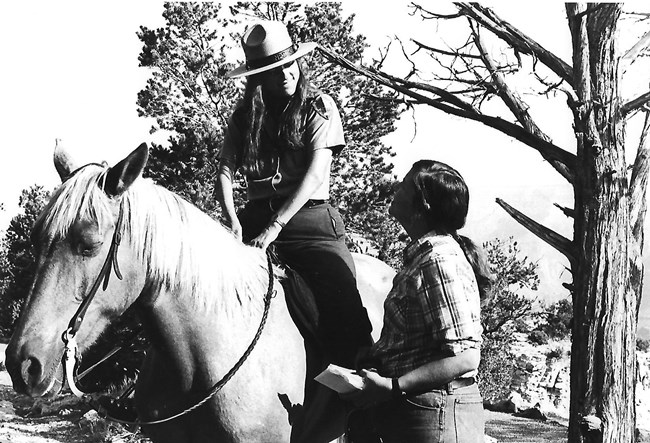
As a ranger, Szychowski found that “people didn’t expect that anyone in a ranger uniform could have a disability.” This assumption led to many awkward encounters with visitors who assumed that the crutches meant she had suffered an accident or made jokes about her falling into the canyon. In fact, a fellow ranger noticed how often people commented on her disability that he decided to track it, discovering that she had to address it 92 times in a single day. Szychowski admits that was “taxing by the end of the day.”
Szychowski always tried to respond matter-of-factly to visitor comments, using humor whenever possible. When she was riding her horse, visitors didn’t notice her disabilities as much. When on the ground, however, they couldn’t help but notice her crutches. To address visitor curiosity and allow them to focus on what she was saying rather than her disability, she started her tours with a brief introduction that addressed the crutches. Sharing that she had a disability, she was quick to let them know that the “good news was that people with disabilities could be rangers.” She recalls that it led to some funny and poignant moments with visitors, “fantastic interactions and opportunities to enlighten them about people with disabilities."
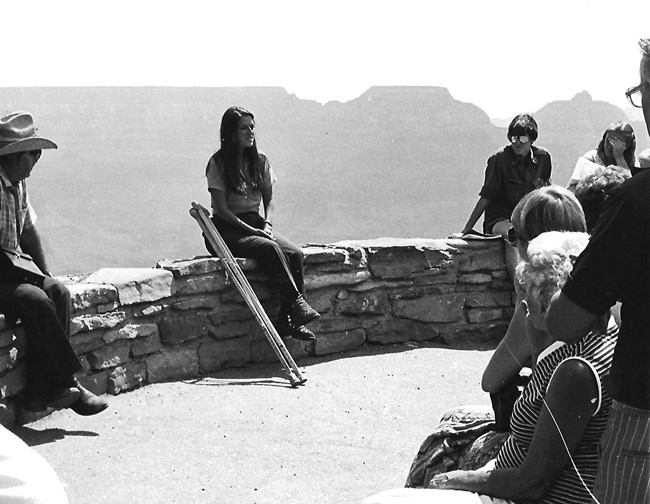
Szychowski, who studied at Cabrillo College and earned a degree in psychology from the University of California-Santa Cruz, only worked as a ranger in 1982. The next year she founded a free therapeutic riding center for children and adults with disabilities. The program grew to encompass a 14-acre, barrier-free, wheelchair-accessible ranch. Szychowski retired in 2004, but her Arizona-based riding center continues her mission.
Szychowski credits the support of her NPS supervisor, Karen Berggren, with the vision that led to her mounted patrols. She describes Berggren as “a committed ally of the disability community.” A Tennessee native, Berggren earned her BS degree in zoology from the University of Tennessee before beginning an NPS career that included positions as a mounted patrol ranger at Great Smokey Mountains National Park and a naturalist at Big Bend National Park before transferring to the Grand Canyon in October 1979. In 1987, she left the NPS to become manager of Homolovi Ruins State Park, a position she held until 2010.
Berggren also hired Annette Wright, a woman who was deaf, to serve as an interpretive ranger at the park in 1983. Wright went on to work for the Arizona Commission for the Deaf and the Hard of Hearing.
Berggren, Szychowski, and Wright lead the way to advocate for people with disabilities and in programs at Grand Canyon. In 1983 the NPS issued Special Directive 83-3, “National Park Service Policies on Accessibility for Disabled Persons,” which committed to making facilities, programs, services, and concession operations accessible. In a January 1985 interview, Berggren told the Arizona Highways magazine that "blind people are welcome on our trails. Those with guide dogs just need to check with the backcountry office so an excursion can be plotted to avoid the mules. People in wheelchairs can negotiate the paved South Rim Trail, from Yavapai Museum to Maricopa Point. Adventurous people in wheelchairs who have the use of their hands and a strong upper torso can qualify for river running on the Colorado."
A lot had changed at Grand Canyon for visitors with disabilities in the four years since Szychowski was denied her mule trip. It would take Changing Attitudes and more legal protections to provide women with disabilities long-term career opportunities in the NPS.
Explore More!
To learn more about the history of women and the NPS uniform, visit Dressing the Part: A Portfolio of Women's History in the NPS.
This research was made possible in part by a grant from the National Park Foundation.
Tags
- arlington house, the robert e. lee memorial
- chickamauga & chattanooga national military park
- george washington memorial parkway
- golden gate national recreation area
- grand canyon national park
- lassen volcanic national park
- muir woods national monument
- ocmulgee mounds national historical park
- olympic national park
- rock creek park
- santa monica mountains national recreation area
- white sands national park
- women's history
- nps history
- accessibility
- african american history
- nps careers
- nps history collection
- hfc
- women
- mounted rangers
- african americans
- disability history
- deaf history
- deaf awareness
- deaf women
